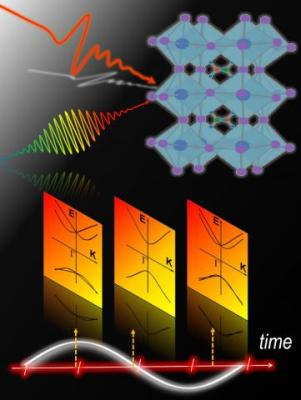Apr 20 2020
Researchers have speculated that a class of light-harvesting “wonder” materials known as the organometallic halide perovskites, which are used for applications in quantum electronics and solar cells, show promise as they exhibit a hidden, yet highly controversial mechanism, known as the Rashba effect.
 Ames Laboratory scientists discovered evidence of the Rashba effect by using extremely strong and powerful bursts of light firing at trillions of cycles per second to switch on or synchronize a “beat” of quantum motion within a material sample; and a second burst of light to “listen” to the beats, triggering an ultrafast receiver to record images of the oscillating state of matter. Image Credit: Ames Laboratory.
Ames Laboratory scientists discovered evidence of the Rashba effect by using extremely strong and powerful bursts of light firing at trillions of cycles per second to switch on or synchronize a “beat” of quantum motion within a material sample; and a second burst of light to “listen” to the beats, triggering an ultrafast receiver to record images of the oscillating state of matter. Image Credit: Ames Laboratory.
At the U.S. Department of Energy’s Ames Laboratory, researchers have now demonstrated, through experiments, the presence of this effect in bulk perovskites. They achieved this by using brief microwave bursts of light for both creating and recording a rhythm, similar to music, of the quantum coupled motion of electrons and atoms in such materials.
For the very first time, organometallic halide perovskites were used in solar cells around 10 years ago. From that time, there have been many studies to investigate their use in electronic transport devices, photonics, and light-harvesting since they provide highly desired dielectric and optical properties.
Organometallic halide perovskites combine the high-energy conversion performance of conventional inorganic photovoltaic devices with the affordable material costs and fabrication techniques of organic editions.
To date, studies have proposed that the remarkable optical, magnetic, and electronic properties of these materials are due to the Rashba effect. It is a mechanism that regulates the electronic and magnetic structure and charge carrier lifetimes.
In spite of the recent in-depth studies and debate around the Rashba effect, there has been no solid proof of its existence in bulk organometallic halide perovskites, utilized in the most efficient perovskite solar cells.
Researchers of Ames Laboratory achieved this proof by making use of terahertz light—highly powerful and strong bursts of light firing at trillions of cycles for every second—to turn on or synchronize a “beat” of quantum motion inside a material sample. A second burst of light was used to “listen” to the beats, which activated an ultrafast receiver to record images of the oscillating state of matter.
This method solved the drawbacks of traditional detection techniques that lacked the sensitivity or resolution to capture the proof of the Rashba effect concealed in the atomic structure of the material.
Our discovery settles the debate of the presence of Rashba effects: They do exist in bulk metal halide perovskite materials. By steering quantum motions of atoms and electrons to engineer Rashba split bands, we achieve a significant leap forward for the fundamental discovery of the effect which had been hidden by random local fluctuations, and also open exciting opportunities for spintronic and photovoltaic applications based on quantum control of perovskite materials.
Jigang Wang, Senior Scientist, Ames Laboratory
Wang is also a professor of physics at Iowa State University.
Further discussions of the study can found in the paper titled, “Ultrafast Control of Excitonic Rashba Fine Structure by Phonon Coherence in the Metal Halide Perovskite CH3NH3PbI3,” by Z. Liu, C. Vaswani, X. Yang, X. Zhao, Y. Yao, Z. Song, D. Cheng, Y. Shi, L. Luo, D.-H. Mudiyanselage, C. Huang, J.-M. Park, R.H.J. Kim, J. Zhao, Y. Yan, K.-M. Ho, and J. Wang. The study was published in the Physical Review Letters journal.
Wang and his colleagues at Ames Laboratory and Iowa State University Department of Physics and Astronomy contributed to the density functional theoretical simulations, model building, and terahertz quantum beat spectroscopy. The perovskite materials with high-quality were offered by the University of Toledo. The phonon spectra simulations were carried out at the University of Science and Technology of China.